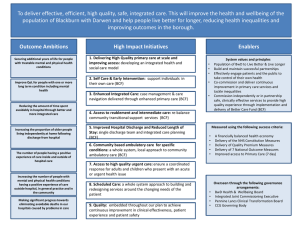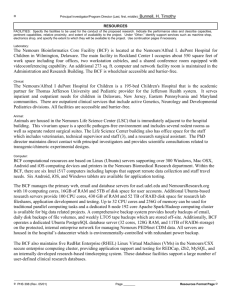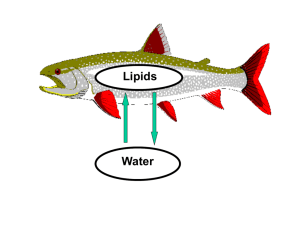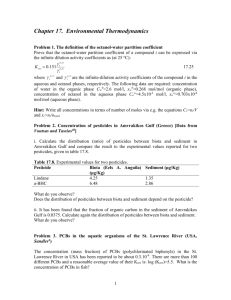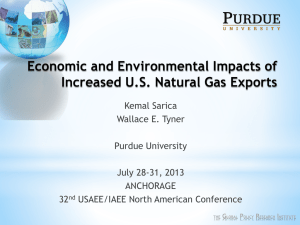ICCA Briefing Paper Log Kow Criteria of 5 is equivalent to BCF
advertisement
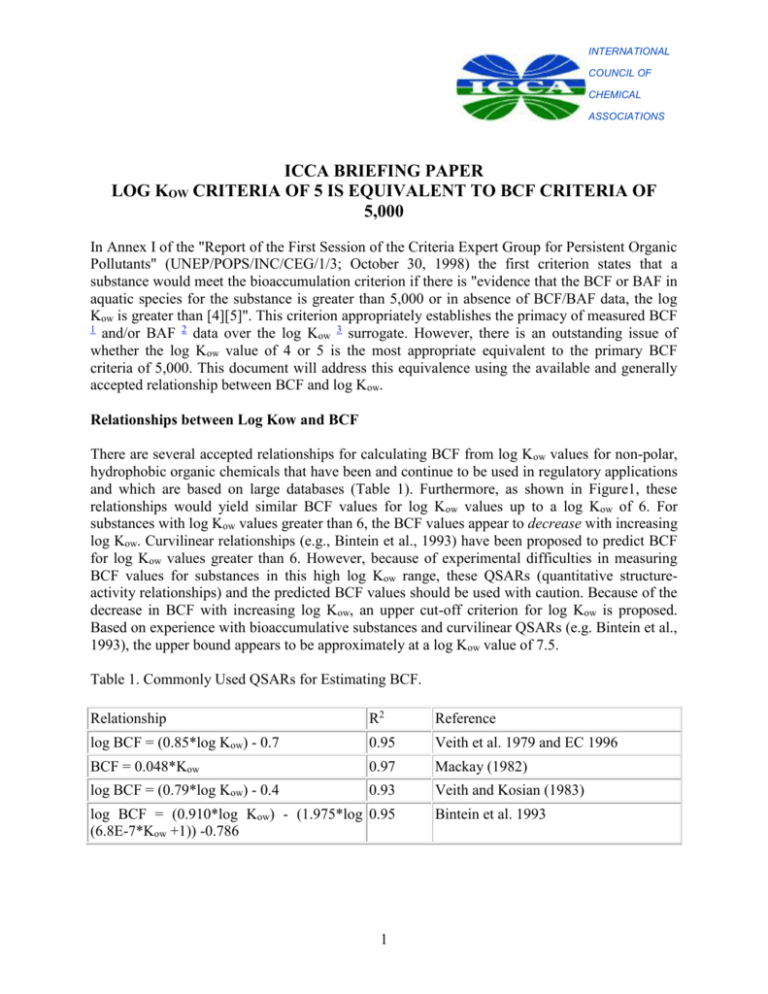
INTERNATIONAL COUNCIL OF CHEMICAL ASSOCIATIONS ICCA BRIEFING PAPER LOG KOW CRITERIA OF 5 IS EQUIVALENT TO BCF CRITERIA OF 5,000 In Annex I of the "Report of the First Session of the Criteria Expert Group for Persistent Organic Pollutants" (UNEP/POPS/INC/CEG/1/3; October 30, 1998) the first criterion states that a substance would meet the bioaccumulation criterion if there is "evidence that the BCF or BAF in aquatic species for the substance is greater than 5,000 or in absence of BCF/BAF data, the log Kow is greater than [4][5]". This criterion appropriately establishes the primacy of measured BCF 1 and/or BAF 2 data over the log Kow 3 surrogate. However, there is an outstanding issue of whether the log Kow value of 4 or 5 is the most appropriate equivalent to the primary BCF criteria of 5,000. This document will address this equivalence using the available and generally accepted relationship between BCF and log Kow. Relationships between Log Kow and BCF There are several accepted relationships for calculating BCF from log Kow values for non-polar, hydrophobic organic chemicals that have been and continue to be used in regulatory applications and which are based on large databases (Table 1). Furthermore, as shown in Figure1, these relationships would yield similar BCF values for log Kow values up to a log Kow of 6. For substances with log Kow values greater than 6, the BCF values appear to decrease with increasing log Kow. Curvilinear relationships (e.g., Bintein et al., 1993) have been proposed to predict BCF for log Kow values greater than 6. However, because of experimental difficulties in measuring BCF values for substances in this high log Kow range, these QSARs (quantitative structureactivity relationships) and the predicted BCF values should be used with caution. Because of the decrease in BCF with increasing log Kow, an upper cut-off criterion for log Kow is proposed. Based on experience with bioaccumulative substances and curvilinear QSARs (e.g. Bintein et al., 1993), the upper bound appears to be approximately at a log Kow value of 7.5. Table 1. Commonly Used QSARs for Estimating BCF. Relationship R2 Reference log BCF = (0.85*log Kow) - 0.7 0.95 Veith et al. 1979 and EC 1996 BCF = 0.048*Kow 0.97 Mackay (1982) log BCF = (0.79*log Kow) - 0.4 0.93 Veith and Kosian (1983) log BCF = (0.910*log Kow) - (1.975*log 0.95 (6.8E-7*Kow +1)) -0.786 1 Bintein et al. 1993 Fig. 1. Comparison of QSARs Log Kow value that Corresponds to BCF criteria of 5,000 The BCF is used to derive the appropriate Kow criteria because it represents the direct accumulation of the substance, i.e. the property of the substance that is of primary concern. Based on the QSARs used in the US, EU and Canada, the value of log K ow corresponding to the BCF criterion of 5000 is in the range of 5 to 7.5 (Table 2). Table 2. Log Kow values Equivalent to a BCF of 5000 for Commonly Used QSARs for Estimating BCF. Relationship log Kow Reference for BCF = 5000 log BCF = (0.85*log Kow) - 0.7 5.2 Veith et al. 1979 and EC 1996 BCF = 0.048*Kow 5.0 Mackay (1982) log BCF = (0.79*log Kow) - 0.4 5.2 Veith and Kosian (1983) log BCF = (0.910*log Kow) - 5.0 (1.975*log (6.8E-7 Kow +1)) -0.786 7.5 and Bintein et al. 1993 2 It has also been determined that substances with a molecular weight (MW) > 1100 are too large to cross membranes into the organism (EEC 1993). Thus, the full recommendation for a secondary criterion equivalent to the proposed primary criterion would be: 5.0 < log Kow < 7.5 and MW < 1100 Limitations of Log Kow as a Secondary Criterion Although it is possible to use these QSARs to estimate BCF for non-polar organic substances, it is important to recognize that none of these QSAR relationships account for metabolism explicitly, although the QSARs may have included BCF data for some substances that could have been metabolized. In fact, the wide variability in measured BCF values is in part due to metabolism. Metabolism can result in measured BCF values for these chemicals that are significantly less than those that would be determined from the log Kow. For example, the BCF for pentachlorophenol is calculated to be 5,500 but the measured value is 195 (Kukkonen and Oikari 1988) and that for dodecylbenzene is calculated to be 10,232,930 versus a measured value of 25 (Werner and Kimerle 1982). Other examples are given in Table 1 of ECETOC (1996) and the dissertations of Sijm (1992) and De Wolf (1992). Thus, the log Kow of 5 would be considered conservative, in some case extremely conservative, since if there is any metabolism the estimated BCF would be higher than the measured BCF. References Bintein, S., J. Devillers and W. Karcher. 1993. Nonlinear dependence of fish bioconcentration on n-Octanol/water partition coefficients. SAR and QSAR in Env. Res. 1:29-39. de Wolf, W. 1992. Influence of biotransformation on the bioconcentration of chemicals in fish. Ph.D. Dissertation. University of Utrecht, The Netherlands. EC. 1996. Technical Guidance Manual EEC. 1993. Technical guidance documents in support of the risk assessment directive (93/67/EEC) for substances notified in accordance with the requirements of Council Directive 67/548/EEC. Brussels, Belgium. ECETOC 1996. The role of bioaccumulation in environmental risk assessment: The aquatic environment and related food webs. Brussels, Belgium. Kukkonen, J. and A. Oikari. 1988. Sulphate conjugation is the main route of pentachlorophenol metabolism in Daphnia magna. Comp. Biochem. Physiol. 91C:465468. Mackay, D. 1982. Correlation of bioconcentration factors. Env. Sci. Technol. 16: 274278 Sijm, D. 1992. Influence of biotransformation and toxicity of chlorinated aromatic compounds in fish. Ph.D. Dissertation. University of Utrecht, The Netherlands. Veith, G.D., D.L. Defoe and B.V. Bergstedt. 1979. Measuring and estimating the bioconcentration factor of chemicals on fish. J. Fish. Res. Board Can. 36:1040-1048. Veith, G.D. and P. Kosian. 1983. Estimating bioconcentration potential from octanol/water partition coefficients. In: Mackay, D., Paterson, S., Eisenreich, S.J., 3 Simons, M.S. (eds). Physical behavior of PCBs in the Great Lakes, Ann Arbor Sciences Publishers, Ann Arbor, P. 269-282. Werner, A.F. and R.A. Kimmerle. 1982. Uptake and distribution of C12 alkylbenzene in bluegill (Lepomis macrochirus). Environ. Toxicol. Chem. 1:143-146. 1 bioconcentration factor bioaccumulation factor 3 logarithm to base 10 of the octanol / water partition coefficient 2 4

